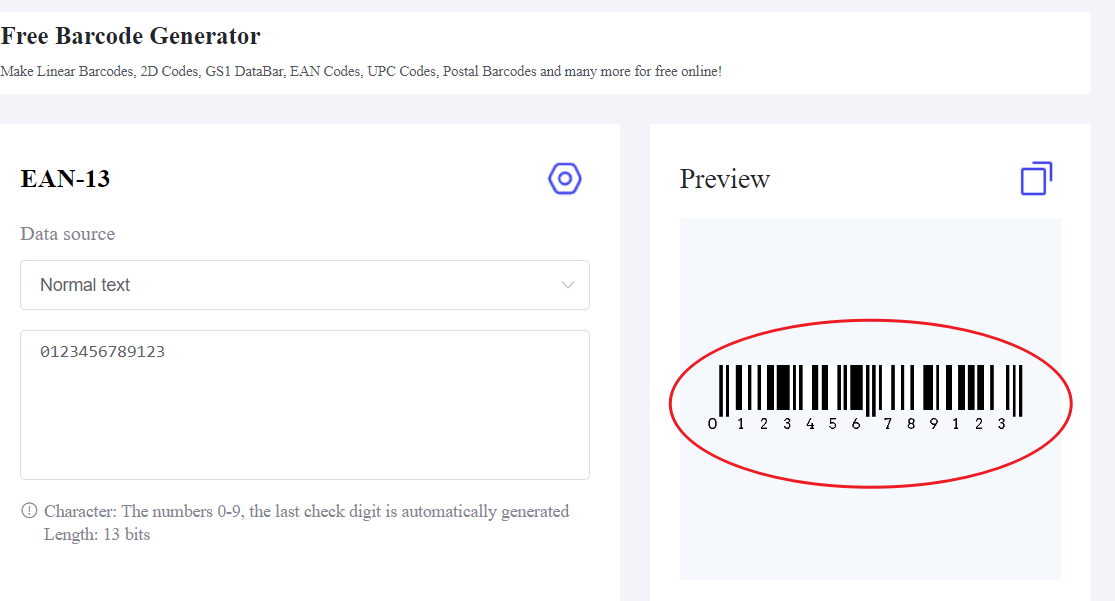In the interconnected global market, the need for standardized product identification is more critical than ever. One of the most widely utilized systems for this purpose is the GTIN-13.
This article offers a complete look at GTIN-13, its format, usage in the USA, comparisons with other GTIN formats, and how to generate GTIN-13 barcodes using an online barcode generator.
What is GTIN-13?
GTIN-13, or Global Trade Item Number 13, is a 13-digit number used internationally to uniquely identify trade items. This system is overseen by GS1, an organization that establishes and maintains global standards for efficient business communication.
The GTIN-13 code is vital for tracking products across various industries, ensuring each item can be distinctly identified, improving inventory management, and enhancing the overall supply chain efficiency.
What is the Barcode Type of GTIN-13?
The barcode type for GTIN-13 is the EAN-13 (European Article Number) barcode. This barcode is widely used internationally, especially outside of North America, and encodes the 13-digit GTIN-13 code, enabling efficient product identification and scanning in retail and supply chain environments.
Can I Use GTIN-13 in the USA?
Yes, GTIN-13 can be used in the USA. Although the United States primarily uses GTIN-12 (commonly known as UPC), the GTIN-13 format is also recognized and accepted. This is particularly important for companies that operate on a global scale, as GTIN-13 facilitates international trade and product identification.
What is the Format of GTIN-13?
The GTIN 13 code comprises 13 digits, structured as follows:
1. GS1 Prefix: The first three digits denote the country of the GS1 member organization that issued the number. It's essential to note that this prefix does not indicate the product's country of origin.
2. Company Prefix: These next digits are unique to the manufacturer or distributor, assigned by GS1.
3. Item Reference: Following the company prefix, these digits are used to identify specific products.
4. Check Digit: The final digit is a check digit, calculated using a standard algorithm, which helps ensure the code's integrity and accuracy.
What is the Difference Between GTIN-12 and GTIN-13?
The primary difference between GTIN-12 and GTIN-13 lies in their length and usage:
● GTIN-12: This 12-digit code is predominantly used in North America and is synonymous with the UPC (Universal Product Code). It includes a 1-digit check digit.
● GTIN-13: This 13-digit code is used internationally and includes a country prefix, making it more suitable for global commerce.
Despite these differences, both GTIN formats serve the same fundamental purpose of unique product identification and can be used interchangeably with appropriate adaptations.
What is the Difference Between GTIN-8 and GTIN-13?
GTIN-8 and GTIN-13 are used in different contexts based on the size and type of the product:
● GTIN-8: This shorter, 8-digit code is typically used for small items where space for a barcode is limited. It's less common and used in specific scenarios.
● GTIN-13: This is the standard 13-digit code used widely across various product types and industries. Its longer format provides more unique combinations, making it suitable for a broader range of products.
How to Generate a GTIN-13 Barcode?
Generating a GTIN-13 barcode is easy when using a GTIN-13 barcode generator. Here's a detailed guide:
1. Obtain a Company Prefix: Register with GS1 to receive a unique company prefix. This step is crucial as it forms part of your GTIN-13.
2. Assign Product Numbers: Using your company prefix, assign unique numbers to each of your products.
3. Calculate the Check Digit: Utilize the GS1 check digit calculator to determine the last digit of your GTIN 13 code.
4. Use a Barcode Generator: Visit a free online barcode generator and input your GTIN-13 code to generate the barcode. The tool will create a barcode image that you can download and use on your product packaging.

What is the Usage of GTIN-13?
GTIN-13 is widely used in retail and supply chain management for the identification and tracking of products.
This 13-digit code ensures that each product can be uniquely identified globally, facilitating efficient inventory management, accurate sales tracking, and seamless integration into retail point-of-sale (POS) systems.
By scanning GTIN-13 barcodes, retailers can quickly retrieve product information, reduce checkout times, minimize human errors, and maintain accurate stock levels.
In addition to retail, GTIN-13 is essential in logistics and warehousing. It allows for the precise tracking of goods through the supply chain, from manufacturers to distributors to end consumers. This ensures that products can be traced back to their origin in case of recalls or quality issues, enhancing transparency and safety.
The global acceptance of GTIN-13 makes it a vital tool for companies operating in international markets, ensuring consistent product identification and compliance with international trade regulations.
Consider a mid-sized retail company that adopted GTIN-13 to streamline its inventory and sales processes.
Before implementing GTIN-13 barcodes, the company faced inventory inaccuracies and slow checkout times. After transitioning to GTIN-13, they experienced a significant reduction in errors and increased customer satisfaction due to quicker checkouts.
This change also facilitated better data analytics, helping the company make informed decisions about stock and sales strategies.
To summarize, the structured format and global recognition of GTIN-13 make it a powerful tool for inventory management, international trade, and consumer transparency.
By using an online GTIN-13 barcode generator, businesses can easily create accurate barcodes for their products, ensuring smooth operations and enhanced efficiency.
For businesses looking to improve their product tracking and inventory systems, adopting GTIN-13 is a strategic move.
Start generating your GTIN-13 barcodes today with a reliable barcode generator and experience the benefits of this globally accepted standard.





